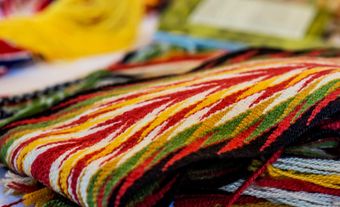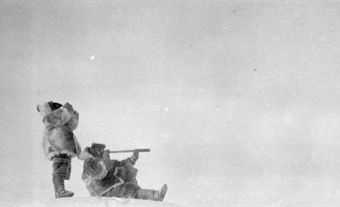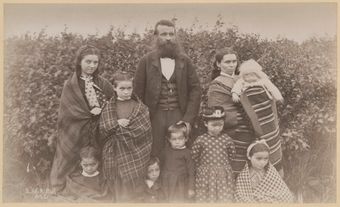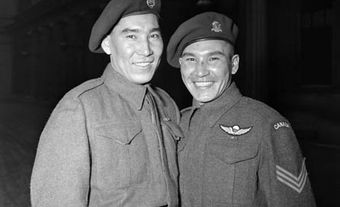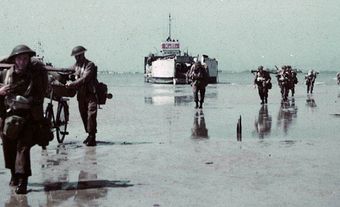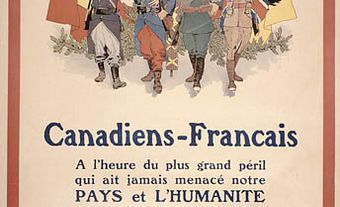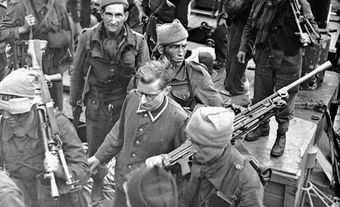In 1939, Canada found itself at war for the second time in a generation. As in the First World War (1914-18), thousands of Indigenous soldiers and nurses volunteered for the war effort at home and abroad, serving with distinction in the Canadian army, navy, and air force. At least 4,250 First Nations soldiers enlisted in the Canadian military in the Second World War, with thousands more Métis, Inuit, and non-Status Indian soldiers serving without official recognition of their Indigenous identity.

Second World War, 1939-45
In 1939, Canada declared war and began building militarily and economically for the Allied cause (see Second World War). Once again, as in 1914 (see Indigenous Peoples and the First World War), Indigenous youth volunteered in the thousands, more still were conscripted, and communities contributed to the national war effort. Arguably, the scale and diversity of Indigenous engagement in the war effort was greater in this conflict, as was the breadth and determination of opposition to conscription. As in the First World War, more is known of Status Indians’ service and experiences, as most Métis were not recorded, and few Inuit served. Indian Affairs (see Federal Departments of Indigenous and Northern Affairs) figures for First Nations enlistments note 3,090, but these figures were woefully incomplete. The numbers for Status Indians were closer to 4,250; the figures for other Indigenous groups are difficult to pinpoint but may have totalled a few thousand. As in the First World War, Indigenous military servicemen and women generally experienced respect, acceptance and promotion in the forces. Brigadier Oliver Martin, a Mohawk from the Six Nations Grand River reserve, was the highest-ranking Indigenous officer of the war.
Did you know?
According to Yann Castelnot, an amateur historian based in Quebec, more than 8,000 Indigenous persons served in the Canadian armed forces during the Second World War. For more than 20 years, Castelnot has researched Indigenous men and women that have served with British, French, Canadian and American forces since the 17th century. As of May 2018, he has identified more than 154,000 individuals, including about 19,000 that have served with Canadian forces.
Recruitment and Military Service
Canada built not only a large army, but also, by war’s end, the world’s third largest navy and fourth largest air force. However, the overall nature of Indigenous military service in the Second World War was little changed from the First World War, as a combination of factors funnelled the vast majority of Indigenous recruits into the army where they were integrated as individuals. Both the Royal Canadian Air Force (RCAF) and Royal Canadian Navy (RCN) required volunteers be “of pure European descent and of the white race,” until 1942 and 1943 respectively. The RCAF appears to have exempted Status Indians from this provision early in the war. Nevertheless, inadequate healthcare and schooling for Indigenous populations in the early 20th century meant few could meet strict medical and demanding education standards. By the mid-point of the war, only 29 Status Indians were in the RCAF, 9 in the RCN (despite the racial barrier) and approximately 1,800 in the army. This pattern held until the war’s end.
Once France surrendered in June 1940, Canada accelerated and expanded its military commitment, and initiated conscription for home defence in September 1940 (see National Resources Mobilization Act). After some uncertainty, Status Indians were included in mandatory military training and military service in Canada. First Nations leaders remembered the limited exemption in 1918 and protested that it was unjust to compel people without citizenship rights to fight to defend those same rights. Nevertheless, this policy remained unchanged until late 1944, when the conscription crisis forced Prime Minister Mackenzie King to begin sending conscripts into combat overseas, including Status Indians. This, however, violated promises made during negotiation of several historical treaties and Indian Affairs requested a limited exemption for Status Indian conscripts, which was passed in December 1944. The exemption covered only recruits from Treaties 3, 6, 8 and 11, roughly one-fifth of the Status Indian population (in the Prairies and Northwest Territories). Relatively few Indigenous men were included in the 2,463 conscripts that saw combat in 1945. While anti-climactic, conscription remained a major concern for Indigenous people throughout the war.
Indigenous Women’s Service
Some First Nations and Métis women are known to have enlisted with the women’s auxiliary services of the Army (CWAC), RCN (WRCNS, “Wrens”) and RCAF (RCAF-WD), filling many different clerical, first aid and mechanical roles, both in Canada and overseas. In all, 72 Status Indian women are known to have served overseas. They experienced many parallels with other servicewomen in the form of pervasive sexism in the forces and a nasty “whisper” campaign in the press that painted women in uniform as promiscuous. Indigenous women saw relatively little in the form of racial prejudice in women’s auxiliaries, as Métis Dorothy Asquith recalled, “[e]verybody was so involved in what was happening with the war nobody was involved in such pettiness.”
Home Front
Indigenous people engaged widely and often enthusiastically in the war effort: donating huge sums to humanitarian and patriotic causes; participating in drives to collect scrap metal, rubber, bones (even from old buffalo jumps); conducting public and ceremonial expressions of support and loyalty; and working in war industries and production in unprecedented numbers. Labour shortages across the country provided more work opportunities, at higher wages, than Indigenous people had ever seen. It was, oddly, the best of times financially for many families.
While collaboration generally characterised Indigenous experience in the Second World War, not all were enthusiastic about joining the cause. Even amongst those supportive, their willingness to contribute was neither unlimited nor unconditional. Wartime taxation and lingering prewar grievances plagued Indigenous–government relations, but conscription inspired more resistance than any other issue. Across the country, and throughout the war, Indigenous communities protested conscription. Young men ignored their call to report for medical examination and avoided authorities (sometimes with support from community elders), and one violent riot broke out when the RCMP tried to arrest draft evaders from the Kahnawake Reserve south of Montréal.
Veterans
Indigenous service personnel returning to Canada in 1945–46 looked forward to the generous and diverse benefits provided by a grateful nation, benefits that were theoretically available to all veterans equally. In practice, however, Status Indians’ access to advising, application forms and all programs was not equal, as Indian Affairs handled most of their case files in ways that disadvantaged many veterans. Métis veterans similarly have felt they were ignored and largely shut out of benefits. Whether or not they received benefits, Indigenous veterans faced a steeper climb to successfully re-establishing themselves in civilian life than their non-Indigenous comrades.
Coming home after years away at war was a happy memory, but many veterans subsequently struggled to settle back into normal life. Large numbers still carried physical and psychological scars; some turned to alcohol to cope or could not remain in one place, or job, for long. Mobility was common, especially for Métis veterans. Undoubtedly, veterans contributed to rapid Indigenous urbanization in the 1950s and 1960s. They also contributed to an increase in Indigenous political organization, especially at the regional and provincial levels, in the post-war period (see Indigenous Political Organization and Activism). However, many found the return to societal racism and marginalization difficult after the acceptance they experienced in uniform. Perhaps this explains anecdotal reports suggesting that many Indigenous veterans re-enlisted for service in the Korean War from 1950 to 1953. Amongst them was the most decorated Indigenous soldier of the Second World War, Ojibwe Sergeant Thomas Prince, who did two tours in Korea.
Legacy and Memory
Unlike during the First World War, Canadians acknowledged Indigenous participation during the Second World War. As the country looked to create a new order in the aftermath of the war, many Canadians suddenly looked at their country’s treatment of Indigenous peoples and did not like what they saw. In this brief climate of recognition, Indigenous leaders, veterans groups and many other Canadians pressured the government for reform and citizenship rights, leading to a Parliamentary review in 1946 and major amendments to the Indian Act in 1951 (though voting rights were not granted at the federal level until 1960; see Indigenous Suffrage). Thereafter, Indigenous veterans were largely forgotten until they began to organize and campaign for recognition of their sacrifices and restitution for grievances over veterans benefits from the 1970s to the 2000s. Perseverance paid off, with a consensus report accepted by both First Nations veterans groups and the government in 2001, followed by an offer of a public apology and offer of compensation in 2003. Métis veterans’ grievances have not received the same hearing. In recent years, Indigenous veterans have gained much greater recognition in local and national acts of remembrance, including Aboriginal Veterans Day on 8 November (inaugurated by Winnipeg’s city council in 1994) and a National Aboriginal Veterans Monument in Ottawa (unveiled in 2001). They are forgotten warriors no longer.

 Share on Facebook
Share on Facebook Share on X
Share on X Share by Email
Share by Email Share on Google Classroom
Share on Google Classroom

